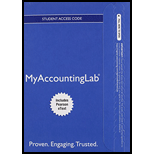
Concept explainers
The accounting equation of the business is based on the double-entry aspects the accounting entries. The books always complete the double-entry aspects of every debit must have a credit.
Therefore, based on this, there always exists an accounting equation which states that the sum of all the assets is equal to the sum of all outside liabilities (referred as total liabilities) and
The above equation always holds good irrespective of the number of transactions handled by the business. Therefore, we can conclude that whenever there is one item (i.e., assets or total liabilities or owner’s equity) is missing for any reason. The same can be computed by applying the accounting equation.
Requirement1:
The computation of the missing amount of expense incurred.
Requirement2:
The computation of net income or loss incurred by the M Company.
Want to see the full answer?
Check out a sample textbook solution
Chapter 1 Solutions
MyLab Accounting with Pearson eText -- Access Card -- for Horngren's Accounting, The Financial Chapters (My Accounting Lab)
- See an attachment for details General accounting question not need ai solutionarrow_forwardPlease provide the correct answer to this general accounting problem using valid calculations.arrow_forwardGrayson Industrial Ltd., which owes Opal Tech Inc. $620,000 in notes payable with accrued interest of $40,000, is experiencing financial difficulties. To settle the debt, Opal Tech agrees to accept from Grayson machinery with a fair value of $580,000, an original cost of $750,000, and accumulated depreciation of $190,000. Requirements: Compute the gain or loss on the transfer of machinery.arrow_forward

 AccountingAccountingISBN:9781337272094Author:WARREN, Carl S., Reeve, James M., Duchac, Jonathan E.Publisher:Cengage Learning,
AccountingAccountingISBN:9781337272094Author:WARREN, Carl S., Reeve, James M., Duchac, Jonathan E.Publisher:Cengage Learning, Accounting Information SystemsAccountingISBN:9781337619202Author:Hall, James A.Publisher:Cengage Learning,
Accounting Information SystemsAccountingISBN:9781337619202Author:Hall, James A.Publisher:Cengage Learning, Horngren's Cost Accounting: A Managerial Emphasis...AccountingISBN:9780134475585Author:Srikant M. Datar, Madhav V. RajanPublisher:PEARSON
Horngren's Cost Accounting: A Managerial Emphasis...AccountingISBN:9780134475585Author:Srikant M. Datar, Madhav V. RajanPublisher:PEARSON Intermediate AccountingAccountingISBN:9781259722660Author:J. David Spiceland, Mark W. Nelson, Wayne M ThomasPublisher:McGraw-Hill Education
Intermediate AccountingAccountingISBN:9781259722660Author:J. David Spiceland, Mark W. Nelson, Wayne M ThomasPublisher:McGraw-Hill Education Financial and Managerial AccountingAccountingISBN:9781259726705Author:John J Wild, Ken W. Shaw, Barbara Chiappetta Fundamental Accounting PrinciplesPublisher:McGraw-Hill Education
Financial and Managerial AccountingAccountingISBN:9781259726705Author:John J Wild, Ken W. Shaw, Barbara Chiappetta Fundamental Accounting PrinciplesPublisher:McGraw-Hill Education





